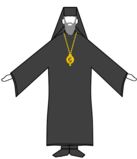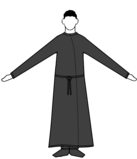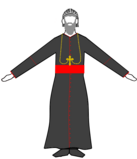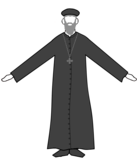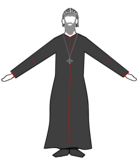Cassock
This articleneeds additional citations forverification.(November 2022) |
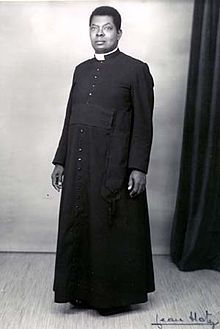
| Part ofa serieson |
| Western dress codes and correspondingattires |
|---|
|
Legend:
|
Thecassockorsoutaneis aChristianclerical clothingcoatused by theclergyandmale religiousof theOriental Orthodox Churches,Eastern Orthodox Churchand theCatholic Church,in addition to some clergy in certainProtestant denominationssuch asAnglicansandLutherans."Ankle-length garment" is the literal meaning of the correspondingLatinterm,vestis talaris.It is related to thehabitstraditionally worn bynuns,monks,andfriars.
The cassock derives historically from thetunicofclassical antiquitythat inancient Romewas worn underneath thetoga,and thechitonthat was worn beneath thehimationinancient Greece.In religious services, it has traditionally been worn underneathvestments,such as thealb.
In theWest,the cassock is little used today except for religious services, save fortraditionalistand those other Catholic clergy and religious who continue to wear the cassock as their standard attire. However, in many countries it was the normal everyday wear of the clergy until the1960s,when it was largely replaced by clerical suits, distinguished fromlaydress by being generally black and by a black shirt incorporating aclerical collar.
InJapan,malegakuranschool uniform were inspired by cassocks.[citation needed]
Etymology[edit]
The wordcassockcomes fromMiddle Frenchcasaque,meaning a long coat. In turn, theOld Frenchword may come ultimately fromTurkishkazak(nomad, adventurer – the source of the wordCossack), an allusion to their typical riding coat, or fromPersianکژاغندkazhāgand(padded garment) –کژkazh(raw silk) +آغندāgand(stuffed).[1]The name was originally specially applied to the dress worn by soldiers and horsemen, and later to the long garment worn in civil life by both men and women. As an ecclesiastical term, the wordcassockcame into use somewhat late (as a translation of the old names ofsubtanea,vestis talaris,toga talaris,ortunica talaris), being mentioned in Canon LXXIV (74) of theAnglican1604 Canons;[2]and it is in this sense alone that it now survives.
The wordsoutaneis aFrenchword, coming fromLatinsubtana,the adjectival form ofsubtus(beneath).[3]
Western Christian practice[edit]
Latin Catholic[edit]



The cassock (or soutane) comes in a number of styles orcuts,though no particular symbolism attaches to these. ARomancassock often has a series of buttons down the front. In some English-speaking countries these buttons may be merely ornamental, with a concealed fly-front buttoning, known as a Chesterfield front, used to fasten the garment. AFrenchcassock also has buttons sewn to the sleeves after the manner of asuit,and a slightly broader skirt. AnAmbrosiancassock has a series of only five buttons under the neck, with a sash on the waist. AJesuitcassock, in lieu of buttons, has a fly fastened with hooks at the collar and is bound at the waist with a cincture knotted on the right side.
The ordinary Roman cassock worn by Roman Catholic clerics (as distinct from that worn as choir dress) is black except intropicalcountries, where because of the heat it is white and usually without shoulder cape (pellegrina). Colouredpipingand buttons are added in accordance with rank: black for priests, purple forchaplains of His Holiness;amaranth redforbishops,protonotaries apostolicandHonorary Prelates;andscarlet redforcardinals.[4]
The 1969 Instruction on the dress of prelates stated that for all of them, even cardinals, the dress for ordinary use may be a simple black cassock without coloured trim.[5]
A band cincture or sash, known also as afascia,may be worn with the cassock. The Instruction on the dress of prelates specifies that the two ends that hang down by the side have silk fringes, abolishing the sash with tassels.[6]A black faille fascia is worn by priests, deacons, and major seminarians, while a purple faille fascia is used by bishops, protonotaries apostolic, honorary prelates, and chaplains of His Holiness, when wearing a cassock with coloured trim. A black watered-silk fascia is permitted for priests attached to thepapal household,a purple watered-silk fascia for bishops attached to the papal household (for example,Apostolic Nuncios), and a scarlet watered-silk fascia for cardinals. The Pope wears a white watered-silk fascia, sometimes with his coat of arms on the ends.
Inchoir dress,chaplains of His Holiness wear their purple-trimmed black cassocks with acotta,but bishops, protonotaries apostolic, and honorary prelates use (with a cotta or, in the case of bishops, arochetandmozzetta) cassocks that are fully purple (this purple corresponds more closely with a Roman purple and is approximated as fuchsia) with scarlet trim, while those of cardinals are fully scarlet with scarlet trim. Cardinals have the additional distinction of having both choir cassock sleeves and the fascia made of scarlet watered-silk. Thecutof the choir cassock is still a Roman-cut or French-cut Roman cassock.
In the past, a cardinal's cassock was made entirely of watered silk, with a train that could be fastened at the back of the cassock. This train was abolished by themotu proprioValde sollicitiofPope Pius XIIwith effect from 1 January 1953.[7]With the samemotu proprio,the Pope ordered that the violet cassock (then used in penitential periods and in mourning) be made of wool, not silk,[8]and in February 1965, under Pope Paul VI, a circular of the Sacred Ceremonial Congregation abolished the use of watered silk also for the red cassock.[9]
An elbow-length shoulder cape, open in front, is sometimes worn with the cassock, either fixed to it or detachable. It is known as apellegrina.It is distinct from the mozzetta, which is buttoned in front and is worn over arochet.
The general rule of the Roman Catholic Church is that the pellegrina may be worn with the cassock by cardinals and bishops.[10]In 1850, the year in which herestored the Catholic hierarchyin England and Wales,Pope Pius IXwas understood to grant to all priests there the privilege of wearing a replica in black of his own white caped cassock.[11]Since then, the wearing of the pellegrina with the cassock has been a sign of a Roman Catholic priest in England and Wales, Scotland, Ireland, Australia, and New Zealand, although sometimes imitated by Anglican priests.
In his 1909 book,Costume of Prelates of the Catholic Church,John Abel Felix Prosper Nainfa proposed[12]the use of the English word "simar",instead of the word" cassock ", for the garment with shoulder cape, which he treated as distinct from the cassock proper. Others too have made the same distinction between the" simar "(with pellegrina) and the" cassock "(without), but many scholars disagree with Nainfa's distinction.[13]More particularly, documents of theHoly Seemake no such distinction, using the termcassockorvestis talariswhether a pellegrina is attached or is not. Thus the 1969 instruction states that, for cardinals and bishops, "the elbow-length cape, trimmed in the same manner as thiscassock,may be worn over it ".[10]Cassock,rather thansimar,is the term that is usually applied to the dress of Popes and other Catholic ecclesiastics. The instruction also gives no support to Nainfa's claim that the cassock with shoulder cape should not be worn in church services, which moreover would be of difficult application, since the cassock with pellegrina is generally made as a single garment, with a non-detachable pellegrina.
Nainfa wrote that at that time the garment with shoulder cape was in Italian called azimarra,a term, however, that in that language is today used rather of a historical loose-fitting overgown, quite unlike the close-fitting cassock with pellegrina worn by Catholic clergy,[14][15]and similar to the fur-linedSchaube[de]that was used in northern Europe.[16][17]Images of the historical zimarra as worn by women can be seen at "Dressing the Italian Way"[18]and "The Italian Showcase".[19]
In cold weather, the manto, an ankle-length cape with or without shoulder cape, or thegreca,also known as the douillette, an ankle-length double-breasted overcoat, is traditionally worn over the cassock. For bishops and priests both the manto and greca are solid black in colour, while for the pope the manto is red and the greca is white.
-
Cardinal
(Often with pellegrina.) -
Bishop
(Often with pellegrina.)
(Also worn by Protonotaries Apostolic
and Honorary Prelates, but without
pellegrina andzucchetto.) -
Chaplain
of His Holiness -
Priest/Deacon/
Seminarian
Anglican and Methodist[edit]

TheAnglican churchuses single and double-breasted cassocks. For many this is to indicate tradition (single-breasted in theAnglo-Catholictradition and double-breasted in theevangelicalend of the church).
The double-breasted cassock fastens at the shoulders on the opposing side of the breast and at the waist with one concealed button. The latter usually has a single small stem-button sewn at centre front about12–15 centimetres (4+1⁄2–6 in) below the centre-front neck line which is used to secure theacademic hood,worn for Choir Dress.
The single-breasted cassock worn by Anglicans traditionally has thirty-nine buttons as signifying theThirty-Nine Articles,or as some would prefer "Forty stripes save one"– the punishmentSaint Paul the Apostlesays he received from the Jews.
Cassocks are often worn without acinctureand some opt for a buckled belt.[20]
Black is the most common colour for priests (presbyters),readers,vergers, and server cassocks. Lighter colours, such as white are used in tropical countries and some cathedrals have colours specific for their location. Piping is also used in the Anglican church to indicate position held with red being used for Deans, Archdeacons and Cathedral Canons.BishopsandArchbishopsoften wear purple cassocks. This has been practise since the 19th century. More recently the Archbishops have chosen to wear black, this can be seen in the ministries ofRowan WilliamsandJustin Welby.A comparatively recent custom - since the reign ofEdward VII- is that scarlet cassocks are properly worn only byChaplains to the Kingand by members of Royal foundations such asWestminster Abbeyand some Cambridge college chapels.[21]They are also worn by the Head Master and Master of the King's Scholars ofWestminster School.[22]Nonetheless, many cathedral canons wear full crimson cassocks rather than with mere piping,[citation needed]as do many servers guilds and choirs due to longstanding practice.

Cassocks are sometimes also worn byreaders,altar servers,andchoirmembers, when they do this is the double-breasted style. Readers and altar servers usually wear black cassocks, but those worn by choirs are usually coloured.[citation needed]
Ministers (presbyters) of theMethodist Church of Great Britainalso traditionally wear a double-breasted cassock (as in the evangelical Anglican tradition).[23]
-
Bishop
-
Canon
(cassock colour may vary) -
Presbyter/Deacon/Layperson
cassock colour may vary if worn
by, for instance, a chorister
Lutheran[edit]
In the Evangelical Lutheran Churches ofDenmark,theFaroe Islands,Iceland,and the North GermanHanseaticcities ofHamburgandLübeck,clergy wear the cassock with theruffasvestments.
The Cassock is also worn occasionally in American Lutheran churches. In previous years, the cassock was worn in combination with a white surplice which almost entirely covered it. It is customary for a minority of clergy to wear it on special high holidays such as Good Friday and Ash Wednesday. Most commonly, Lutheran pastors wear analbover a clerical shirt (with clergy collar).Vestments,most commonly astole,are worn over the alb.
Presbyterian[edit]
In theChurch of Scotland,and Presbyterian churches which trace their heritage back to the Scottish church, they typically use the Anglican style of cassock. In addition, it is not uncommon to see full-length cassocks worn in the blue of theFlag of Scotland,which is also tied to the academic dress of theUniversity of St Andrews.As is the custom within the Church of England, ministers of the Church of Scotland who are chaplains to the royal family also wear a scarlet cassock. Over this is typically worn apreaching gownor theacademic gownof the minister. During theEdwardianandVictorianera, it was common to see a shortened, double-breasted black silk cassock worn under the gown. It generally reached to the knees and was tied with a simplecincture.However, with theliturgical movementof the 20th century, the classic cassock came back into fashion.
Presbyterians in Canada tend to follow the custom of the Church of Scotland, whereas Presbyterians in the United States typically wear an American Geneva gown over a sleeveless cassock or a non-cuffed gown over an Anglican or Roman style cassock. The AmericanGeneva gownis often supplied with a cuff sewn into the double-bell sleeve (this innovation is a remnant of the cassock sleeve that was formerly worn underneath).
As is the practice in the Anglican churches, cassocks may be worn by others who are not ministers. Ordained elders and deacons, as they serve as worship leaders, readers, and administer communion may also wear cassocks which tend to be black. Those worn by choirs and other worship leaders are usually coloured (for instance, The Shadyside Presbyterian Church (U.S.A.) choir is dressed in red cassocks under white surplices).
Eastern Christian practice[edit]
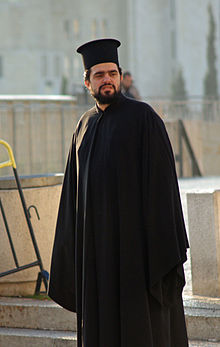
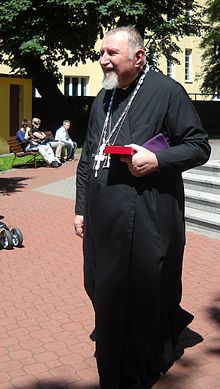
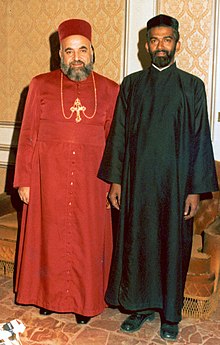
In Eastern Christianity there are two types of cassock: the Inner Cassock and the Outer Cassock or Rason. Monastics always wear a black cassock. There is no rule about colouration for non-monastic clergy, but black is the most common. Blue or grey are also seen frequently, while white is sometimes worn forPascha.In the Eastern Churches, cassocks are not dress for any lay ministry. Generally, one has to be blessed to wear a cassock usually in the case of exercising a clerical duty.
Types of Eastern cassocks[edit]
- Theinner cassock(more often simplycassock) is an ankle length garment worn by all major and minor clergy, monastics, and often by maleseminarians.The Slavic, or "Russian" style (Russian:подрясникpodryasnik,Ukrainian:підрясникpidryasnyk) is double-breasted, closely fitted through the torso and flaring out to the skirt, with a high collar buttoned off-center, and may be cinctured with either a leather or wide cloth belt.[24]TheGreekversion, called ananteri(αντερί),rason(ράσον), orzostiko(ζωστικό) is somewhat fuller, gathered at the waist with a narrow cloth belt, and with a high collar buttoned in the front.[25]The inner cassock is usually worn by all clergy members under their liturgical vestments.
- Theouter cassock(Russian:рясаryasa,Ukrainian:рясаryasa,Ancient Greek:εξώρασον, ράσονexorason) is a voluminous garment worn over the inner cassock by bishops, priests, deacons, and monastics as their regular outerwear.[26]It is not worn by seminarians,readersorsubdeaconsin the Russian tradition. In the Greek tradition, however, chanters may wear it in church, usually with no inner cassock beneath but directly over secular clothing. The outer cassock should be worn by a priest celebrating a service such asVesperswhere the rubrics call for him to be less than fully vested, but it is not worn by any clergy beneath thesticharion.It may be worn with the bottoms of the sleeves turned back, which are sometimes faced in a contrasting colour. The Greek version tends to be somewhat lighter weight and more fully cut than the Russian. It is originally a monastic garment, and in the Russian tradition a man must be explicitly blessed by thebishopto wear it following his ordination to thediaconate.
- Acassock vest( "kontorasson" (κοντόρασον), "amaniko" (αμάνικο), "gileko" (γιλέκο)) is sometimes worn over the inner cassock. This is a closely fitted collarlessvest,usually falling slightly below the waist. The vest has its origins in the outer cassock and therefore should be worn only by clergy and monastics who would, in formal or liturgical settings, wear the outer cassock.[27][28]
- Acassock coatmay be worn on very cold days, with the same cut as the outer cassock but slightly larger and of heavier material. It may or may not have a fur-lined collar.[29]The coat is worn over the outer cassock, although many clerics may wear it in lieu of a coat on colder days.
Eastern Catholic and Orthodox examples[edit]
-
Bishop
-
Priest with grey Zostikon, a
Kontorasson, and a Skufia. -
Priest (married)
-
Hieromonk (celibate Priest)
-
Monk
-
Chanter/Subdeacon/Deacon
dressed in the Zostikon
Oriental Orthodox examples[edit]
-
Syriac Patriarch
-
Syriac Bishop
-
Coptic Priest
-
Syriac Priest
-
Coptic & Syriac Priest
(monk)
Non-clerical 17th-century garment[edit]
The termcassockcan also refer to a loose-fitting, pullover, hip-lengthjacketworn by ordinarysoldiersin the 17th century.[citation needed]A cassock has attachedsleevesand is open down the sides, similar to amandilion.Such garments are popularly recognized as the formal uniform of theMusketeers of the GuardinThe Three Musketeers– though this is suspect historically.
References[edit]
- ^"Online Etymology DictionaryandAmerican Heritage Dictionary of the English Language".Archivedfrom the original on 4 March 2010.Retrieved14 March2010.
- ^"Decency in Apparel enjoined to Ministers".Constitutions and Canons Ecclesiastical Of the Church of England.Archivedfrom the original on 26 January 2021.Retrieved21 February2021.
- ^"Collins English Dictionary".Collins English Dictionary.Archivedfrom the original on 21 August 2014.Retrieved25 August2014.
- ^"Instruction on the Dress, Titles and Coats-of-Arms of Cardinals, Bishops and Lesser Prelates, 28 March 1969".Fiu.edu.Archivedfrom the original on 2 June 2017.Retrieved25 August2014.
- ^Instruction, 5 and 14[full citation needed]
- ^Instruction, 3, 15, 18, 19[full citation needed]
- ^"Valde solliciti,I "..fiu.edu. Archived fromthe originalon 4 March 2016.Retrieved25 August2014.
- ^Valde solliciti,III
- ^"The Cardinals of the Holy Roman Church: Guide to documents and events"..fiu.edu. Archived fromthe originalon 26 October 2015.Retrieved25 August2014.
- ^abInstruction on the Dress, Titles and Coats-of-Arms of Cardinals, Bishops and Lesser Prelates, 28 March 1969, 2 and 14
- ^"England & Wales 1550–1850, s.v." Clerical dress "".Catholic History. 12 November 1918. Archived fromthe originalon 21 October 2013.Retrieved25 August2014.
- ^Nainfa, John Abel (1909).Costume of Prelates of the Catholic Church: According to Roman Etiquette.John Murphy.ISBN9785881504113.Archivedfrom the original on 20 April 2024.Retrieved30 March2023.
- ^"Edward McNamara," Birettas and Academic Hats at Mass "".Ewtn.Archivedfrom the original on 14 July 2014.Retrieved25 August2014.
- ^"Italy in the 16th century".Threadwalker.net. Archived fromthe originalon 25 March 2012.Retrieved25 August2014.
- ^zimarra[circular reference]
- ^Zimarra[circular reference]
- ^images in Wikimedia Commons
- ^"Dressing the Italian way".Aneafiles.webs. Archived fromthe originalon 4 April 2011.Retrieved25 August2014.
- ^"The Italian Showcase - Chris at the Realm of Venus".Realmofvenus.renaissanceitaly.net.Archivedfrom the original on 12 March 2015.Retrieved25 August2014.
- ^Edwards, Nina (15 December 2011).On The Button.I.B.Tauris. p. 178.ISBN9781848855847.
In the Roman Catholic version the 33 buttons are said to represent the years of Jesus's life; in the Anglican the 39 buttons are thought by some to represent the 39 Articles of Faith. The Ambrosian cassock has only five buttons, with a broad sash at the waist; the French cassock has buttons elegantly up the sleeves as in a modern lounge suit; Jesuits prefer a fly fastening and no buttons on show whatsoever.
- ^"Out of the question: Peculiar colour of cassocks".Church Times.26 November 2010.Archivedfrom the original on 28 October 2021.Retrieved5 April2021.
- ^Charles, Robert HG (2015)."Odds & Ends of Westminster School"(PDF).OldWestMinstersLodge.org.Archived(PDF)from the original on 12 February 2022.Retrieved19 November2020.[circular reporting?]
- ^Wallwork, Norman (1986).Blackbirds and Budgerigars: Critical History of Methodist Liturgical Dress 1786-1986(PDF).Stoke-on-Trent, England: Methodist Sacramental Society.ISBN978-0951259917.Archived(PDF)from the original on 28 November 2022.Retrieved28 November2022.
- ^"See for example".Archivedfrom the original on 23 October 2013.Retrieved25 August2014.
- ^"See for example".Archivedfrom the original on 3 March 2016.Retrieved25 August2014.
- ^"Image: r20w.jpg, (111 × 252 px)".nikitatailor.Archivedfrom the original on 16 October 2006.Retrieved23 September2015.
- ^"Image: v1w.jpg, (135 × 252 px)".nikitatailor.Archivedfrom the original on 12 September 2005.Retrieved23 September2015.
- ^"Image: 106ant_exot.jpg, (480 × 640 px)".kwvestments. Archived fromthe originalon 13 July 2011.Retrieved23 September2015.
- ^"Image: furw.jpg, (121 × 252 px)".nikitatailor.Archivedfrom the original on 15 June 2007.Retrieved23 September2015.









